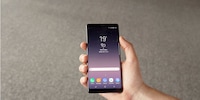
News + Trends
Samsung Galaxy Note 8 – It’s big, it’s strong and it’s armed with a pen
by Dominik Bärlocher

Samsung set the bar with the Samsung Galaxy S8 and then went one better with the Note 8. The South Korean company set its sights on office orders rather than just home use. To do that, Samsung developed DeX, a docking station for your smartphone that turns your mobile into a PC. But what exactly can DeX do?
The DeX docking station is small and only features a couple of ports. Are you really supposed to be able to put in a day’s work on that? Challenge accepted. I didn’t think the setup would be too difficult. But this theory would later come back to haunt me.
As far as hardware goes, the DeX Station is easy to use. There is no additional computing power built into the dock. A single cooling device on the back is supposed to stop the device from overheating. But why would it need computing power built in?
The specs of the Note 8 and the S8 series are more than enough to replace a fairly powerful PC. Even though Samsung phones don’t come close to the performance of a gaming rig, they are still enough to replace the usual office grind. The only downside is you’ll never be able to play Crysis on the Note 8.
This all means DeX is geared towards work in the office, too. This is an area where Microsoft have been successful for years. The majority of revenue from the Windows manufacturer and their partners comes from the office segment. Not convinced? Take a look around your office.
At digitec, we’ve got Dell screens and HP computers. There are almost 500 of us in the Zurich office. That translates into 1,000 screens and 500 laptops, 500 docking stations and 500 keyboards and 500 mice. It’s not as if we can forego these devices. I’d be a bit stuck without my PC. In fact, I couldn’t do my job. This is something that HP, Dell, Microsoft and Co. obviously use to their advantage.
I’m not surprised Samsung wanted a piece of the pie as well.
Even journalists can replace their whole mountain of technology with the current Galaxy series devices. Now that’s something I’d like to see.
I’ve got the DeX Station in front of me, and it’s now time to unpack it. As it happens, there’s not much in the box. There aren’t any HDMI cables or other accessories that come with it. You have to buy those separately. Over a few months, I’d built my own charging station compatible with all kinds of USB devices. All I had to do was plug DeX in. This is what the setup looked like:
That was just the test setup, as the keyboard didn’t work. It wasn’t that the K200 was doing anything wrong per se, but it wasn’t doing much right either. If you already follow my articles, you’ll know I’m a fan of mechanical keyboards. However, as I only had two USB 3.0 ports and I want to use one of those for the mouse, I didn’t think it was a good idea to make DeX work too hard to begin with. For now, I just wanted to see if it worked. Besides, any decent keyboards I have need two ports all to themselves.
After all that it didn’t work.
What happened?
I remembered back to the two demonstrations I saw of the devices in London. They popped the mobile into DeX and DeX started. The only thing was, it didn’t work like that for me. To make sure the issue wasn’t with my phone, I borrowed an S8 from digital marketing manager Sandro Hostettler. That didn’t work either. There was nothing for it but to fire up Google and head for the official Samsung page. Amid the mass of text, I found a throwaway remark that perplexed me:
Use the Samsung Adaptive Fast Charger to connect the DeX Station to the power grid
You’re supposed to use Samsung’s own charger? Right, OK. I gave that a go and by some miracle it worked. If our Zurich office were to switch over to DeX, we’d have to buy 500 new chargers and 500 cables straight away. I don’t think that’s fair, as I very much doubt there’s a big difference between a Samsung charger and my own RavPower charger.
But anyway, my Note 8 was now asking me if I wanted to activate the DeX interface. I only had to select this option once as the Note remembered my preferences whenever my phone was in the DeX Station.
Things seemed to be going well – DeX started up and I could start work – so I let myself get ambitious. I wanted a decent keyboard. I was reluctant to disconnect my customised Corsair STRAFE from my PC, because I didn’t want to have to repair something that wasn’t broken. Instead I used a device that the head of Strategic Category Management Osman Erdogan had given me to test out, the HyperX Alloy Elite.
This had two USB ports: one for operating the keyboard and the other for USB passthrough and backlighting. I could live without the luxury, but I didn’t want to. So I plugged in an Icy Box USB Hub. This is what my setup looked like.
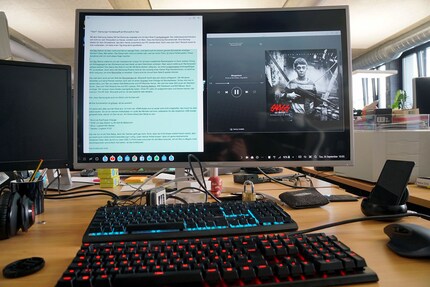
My desk wouldn’t have looked out of place in a 90s action film. What’s not to like, kids?
Time for work. After half an hour of bug-hunting, I had mastered the impressive move called «put your phone in the DeX Station and the interface appears». The time it took to connect the DeX/Note and for it to be ready to use on the PC was a few seconds at most. I needed slightly longer to disconnect them, but after a few seconds I could use the phone for its original purpose again. The process was easy, as all you had to do was take the phone out of the DeX Station. That got a thumbs up from me.
Plugging it in was a bit cumbersome to begin with and required gross sensory motor skills. But with all the meetings and breaks throughout the day, you get the hang of it. There is one nice side effect to the whole affair. When I used my Note 8 with DeX for work, it was constantly getting charged up, which solved my battery problem.
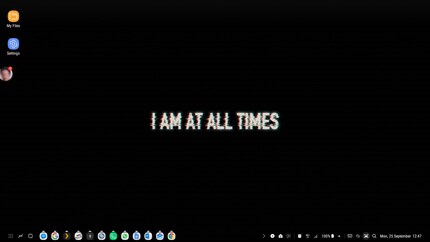
The DeX desktop with a quote from Henry Rollins
The desktop is tidy and minimalistic. What’s really cool is that all the apps I had open on the Note 8, which you could see when you pressed the □ button, were stored in the equivalent of the taskbar in Windows. The notification area and everything else was stored on the bottom right. I was able to customise my desktop image and choose photos from my photo album. I selected AMOLED-compliant wallpaper, as I wasn’t too keen on the purple Galaxy hues DeX was offering.
The work itself resembled Remix OS, a now discontinued operating system that was designed for using Android on laptops. I had all my apps at my fingertips, and most notifications appeared in the notification area at the bottom right. Outlook was still playing hard to get, but I’m pretty sure that had to do with me overlooking a setting somewhere. WhatsApp and Facebook Messenger worked flawlessly.
I’m still impressed that all my apps apart from the browser worked. It proved to be a remedy for my usually torrent of tabs. I now have windows side by side again, and app notifications can appear independently of the window. Let’s hear it for DeX.
I still think a few improvements are needed before DeX can be the death of Windows. The whole operating system only seems 95% finished. The main problem isn’t with the hardware, as that exceeds all expectations.
All the problems were to do with the software. None of them were major problems or issues that threaten the future of DeX. They were just aspects that are annoying enough to make you reconsider buying a DeX System – especially if it were a large-scale company order.
Most apps from the main manufacturers recognise that more than just a mobile is involved, with Microsoft leading the way in that regard. They switch to a separate mode that has been optimised for the docking station. It’s pretty impressive and really powerful.
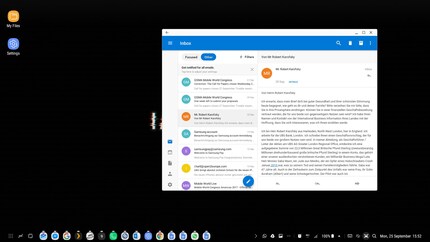
Outlook switched to a special mode that facilitates workflow
I started to think how good it would be if the phone could serve as the notification area. The black rectangular shape of my Note is in my field of sight when it’s sitting on my desk. The phone could show notifications like a mini screen would.
After my article from London where I held the Note 8 for the first time at an exclusive press event, I was asked about the loudspeakers. What kind of volume can you expect? What is the sound like? In two words: surprisingly good.
This becomes relevant with DeX if you forget to divert the audio output from the phone to HDMI. Because when you’re in the office, headphones are your best friend. Unfortunately, these can’t be plugged in during DeX mode. The DeX Station doesn’t have an audio outlet. You can’t even plug the headphones into your phone, as the jack is on the bottom right next to the connector for the DeX Station. But all in all, the speakers produce impeccably clear sound that’s loud and rarely tinny.
I’m sure you’ve used instant messaging before. In Skype, Facebook Messenger, WhatsApp or any other app, you’d press enter and the message would send. When you do the same in DeX, you just create a new line. To send the message, you have to use the mouse and click on send. That all sounds like too much effort to me.
«It surely can’t be that difficult,» I thought to myself and went over it with engineer Mohammed Ajil. Our first point of reference was the Android developer site, which lists all the available commands and functions. I’d like to give some brief and perhaps shallow-sounding praise here for open source software that lets us do these kinds of tests.
As DeX is an almost unrecognisable Android version, we were almost certain we were on the right path. Android came to life nine years ago as a multifunction system, which is why amongst other elements, they built in physical keyboards. This means Android can at least be used as an interface for touch screens and be paired with physical keyboards. Well, in theory. In practice, this is handled by the function known as onKeyDown() and onKeyUp().
@Override
public boolean onKeyUp(int keyCode, KeyEvent event) {switch (keyCode) {
case KeyEvent.KEYCODE_D:
moveShip(MOVE_LEFT);
return true;}
}The developer site didn’t recommend using onKeyDown(), as this could trigger several events. It would be like writing «ffffffffffff...» when you hold down the F key. That’s why coders need to use onKeyUp().
The above code says «Move a ship to the left when you press the D key.»
This demonstrates that the error isn’t anything to do with DeX or Samsung but with Facebook. Every Android app has its own commands and keybindings. In other words, someone will have to ask Facebook to resolve the issue. To be honest, I find it rather strange that the company hasn’t realised there are people out there using their app with physical keyboards.
As far as a solution to the enter issue is concerned, this is what the code would have to look like in Messenger. Unfortunately, we didn’t have time to take the Messenger app apart, which is why we’re just using placeholders here.
@Override
public boolean onKeyUp(int keyCode, KeyEvent event) {switch (keyCode) {
case KeyEvent.KEYCODE_ENTER:
sendMessage();
return true;}
}Or at least, something along those lines. According to the developer site, KEYCODE_ENTER is the constant for the enter key. The rest you can invent yourself. You can’t use the code given above, as it has holes and hasn’t been tested.
After I showed Mohammed the code, I received an avalanche of questions, including «What happens if I link a Bluetooth keyboard with the mobile?» The answer is, we don’t know. And you won’t find out here, as we were short of time. Mohammed’s verdict: «Either messenger apps don’t account for physical keyboards or DeX is handling the event the wrong way.»
Once you’ve finished working with DeX, you just take the phone out of the DeX Station. There weren’t any complicated ejecting procedures or manual changing of modes. You just needed to give the Note 8 a few seconds until the screen and the DeX system switched back over to phone mode.
Most apps didn’t register any problems during this phase with the exception of Messenger. There are probably other apps that show faulty behaviour errors. Messenger was just the first one I came across.
Apps and symbols are scaled on DeX. This works best from phone to DeX, even with Facebook Messenger Chat Heads. But from DeX to phone, an error slipped in. While the Chat Heads were on the screen, the Messenger app that generated the overlay with the Chat Heads no longer scaled. As a result, I ended up with little heads floating around somewhere in the middle. And they’re tiny. Even after I’d killed the app I still noticed graphics errors.
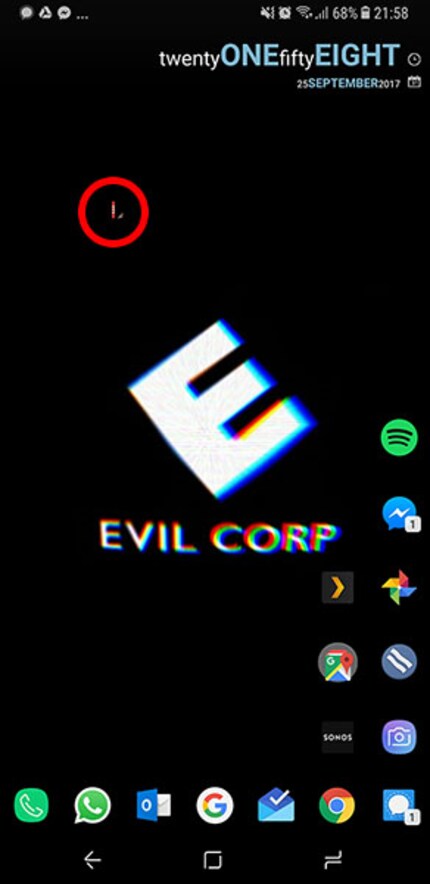
The Messenger error

Detailed view
Basically, Messenger and DeX don’t get on.
That’s one of the reasons I hope DeX gains acceptance. The idea of using your smartphone as a PC via a dock is fantastic and forward-thinking. DeX is 95% complete and works extremely well considering its plainness and Android versions.
DeX isn’t the death knell for PCs as was initially thought. The software still has bugs and functions that haven’t been implemented properly. But that’s to be expected when you’re dealing with such a new smartphone model to be used as a PC.
Nonetheless, I was still very taken with the idea. The standard Samsung set with DeX promised a lot but didn’t deliver on it all. So my request to Samsung is this: Please repair your device. Talk to app developers and make them turn DeX into a tempting concept. Ask for a few more lines of code in the places where it’s missing. Then you’ll have an infrastructure that represents undeniable competition for PCs.
Last night, I got an e-mail from Samsung. It was good news. Well, sort of. They gave me an electronic earful for not using the power supply that came with the device. How did they know that?! But I guess, if you do everything right during setup, it doesn’t occur to you to use another charger.
That aside, here’s the good news: «What a great article. We’re glad to hear you like the DeX. We’re sure the bugs you mentioned will be a thing of the past soon.» Yay! Samsung Switzerland, you’re my heroes.
Journalist. Author. Hacker. A storyteller searching for boundaries, secrets and taboos – putting the world to paper. Not because I can but because I can’t not.